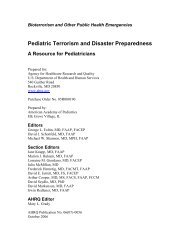H1N1 COUNTERMEASURES STRATEGY AND ... - PHE Home
H1N1 COUNTERMEASURES STRATEGY AND ... - PHE Home
H1N1 COUNTERMEASURES STRATEGY AND ... - PHE Home
Create successful ePaper yourself
Turn your PDF publications into a flip-book with our unique Google optimized e-Paper software.
NBSB Pandemic Influenza Working Group<br />
Detailed Report<br />
each product on a case-by-case basis and may establish conditions to restrict use of the<br />
product. FDA consults with NIH and CDC before approval of an EUA. Dr. Hojvat<br />
summarized the four statutory criteria for consideration of an EUA.<br />
A request for an EUA can come from any source, and FDA encourages submitting data<br />
for pre-EUA consideration when feasible. With data in hand, FDA would be able to<br />
move more quickly once an emergency is declared. The EUA expires when the<br />
emergency ends, and the product can no longer be used unless it’s licensed. FDA<br />
encourages manufacturers and other applicants to be prepared to apply for licensure or<br />
consider a parallel clearance process for its EUA submission.<br />
Requests for EUAs are prioritized on the basis of several factors, such as the following:<br />
<br />
<br />
<br />
<br />
<br />
<br />
<br />
<br />
<br />
Seriousness of the clinical condition<br />
Incidence of the clinical condition<br />
Effect use of the product may have on ensuring national security<br />
Availability of product in government stockpiles<br />
Feasibility of use of product in a large population<br />
Request of another government agency<br />
Availability of a similar product<br />
Adequacy of supporting non-clinical and clinical information<br />
Quantity of product available<br />
Dr. Hojvat described the information that FDA requests for an EUA; she stressed that if a<br />
test has been validated in a lab, all of the requested information should be available.<br />
FDA has approved only two EUAs for <strong>H1N1</strong> to date: the CDC PCR kits and the fivetarget<br />
panel. It is currently reviewing about six formal requests and multiple unofficial<br />
inquiries, all involving nucleic acid-based diagnostics. None of the requests include true<br />
POC rapid diagnostic devices. For EUA denials, FDA is working with the submitting<br />
party on products that might be useful in the fall and cleared either through an EUA or<br />
the 510k clearance process. EUA approval requires input from NIH and CDC.<br />
FDA’s short- and long-term strategy for diagnostics involves the following:<br />
<br />
<br />
<br />
<br />
Continuing to work closely with CDC, NIH, and HHS on preparation/testing<br />
needs strategy for upcoming influenza season.<br />
Making information required for EUA authorization widely available and<br />
establishing a standard template for validation of all <strong>H1N1</strong> diagnostics.<br />
Rapidly granting EUA authorization for diagnostics that support public health<br />
needs. Prioritizing review of existing/new diagnostics if virus reassortment<br />
occurs.<br />
Encouraging submission of 510(k)s as <strong>H1N1</strong> becomes a “seasonal <strong>H1N1</strong>.”<br />
59
















